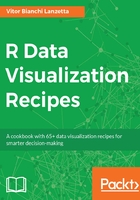
Making plots using primitives
Previously, a brief introduction on the frameworks of ggplot2, ggvis and plotly package was conducted. Next we are getting started with ggplot2 graphical primitives, using them in a series of recipes with related examples made with ggvis and plotly.
There are a total of eight graphical primitives at ggplot2, one of them already covered in this chapter (geom_point()). It's important to know the primitives well-what they do and when to use them. As fundamental building blocks, they play an essential role in the drawing process. A series of tasks can be handled relying on primitives when there is no dedicated function to handle some task; sometimes even if there is, primitives can handle it much better.
A good example are the dot plots. They have this dedicated geom_dotplot() function, but sometimes it is much easier to draw dot plots using geom_point(). Now, let's see how ggplot2 can brew figures using primitives and create related ones using ggvis and plotly.